Antoine-Jean Gros
Antoine-Jean Gros (French pronunciation: [ɑ̃twanʒɑ̃ gʁo]; 16 March 1771 – 25 June 1835), titled as Baron Gros in 1824,[1] was a French painter.[2] His work was in the genres of history and neoclassical painting.
Antoine-Jean Gros | |
|---|---|
 Antoine-Jean Gros at age 20, c. 1791 | |
| Born | 16 March 1771 |
| Died | 25 June 1835 (aged 64) near Meudon, France |
| Resting place | Père Lachaise Cemetery |
| Nationality | French |
| Education | Collège Mazarin |
| Known for | Painting |
Gros studied under Jacques-Louis David in Paris and began an independent artistic career during the French Revolution. Forced to leave France, he moved to Genoa and witnessed the nearby Battle of Arcole (1796). Inspired by an event during the battle, he produced a portrait of the French commander, Napoleon Bonaparte, then a newly promoted general. The portrait brought Gros to public attention and gained the patronage of Napoleon.
After travelling with Napoleon's army for several years, he returned to Paris in 1799. Gros produced several large paintings of battles and other events in Napoleon's life. These were mostly in a neoclassical style, but Napoléon on the Battlefield of Eylau adopted a more realistic portrayal of the horrors of war. Gros also painted portraits of officers in the French army and members of French high society. After the fall of Napoleon, he shifted his artistic focus and produced more history paintings, which art historians regard as less impressive than his earlier work.
Early life and training

Born in Paris, Gros began to learn to draw at the age of six from his father, Jean-Antoine Gros,[3] who was a miniature painter, and showed himself as a gifted artist. His mother, Pierrette-Madeleine-Cécile Durand, was also a painter.[4] Towards the close of 1785, Gros, by his own choice, entered the studio of Jacques-Louis David, which he frequented assiduously, continuing at the same time to follow the classes of the Collège Mazarin.[5]
The death of his father, whose circumstances had been embarrassed by the French Revolution, threw Gros upon his own resources in 1791. He now devoted himself wholly to his profession, and he competed (unsuccessfully) in 1792 for the grand prix. Around this time, however, on the recommendation of the École des Beaux Arts, he was employed on the execution of portraits of the members of the National Convention, but disturbed by the development of the Revolution, Gros left France in 1793 for Italy.[5]
Genoa and Bonaparte
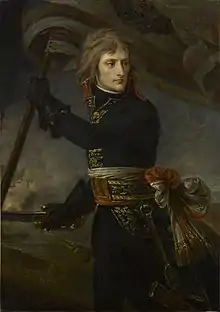
He supported himself at Genoa by the same means, producing a great quantity of miniatures and fixés. He visited Florence, but returned to Genoa where he made the acquaintance of Joséphine de Beauharnais. He followed her to Milan, where he was well received by her husband, Napoleon Bonaparte.[5]
On 15 November 1796, Gros was present with the army near Arcola when Bonaparte planted the French tricolor on the bridge. Gros seized on this incident, and showed by his treatment of it (entitled Bonaparte at the pont d'Arcole) that he had found his vocation. Bonaparte at once gave him the post of inspecteur aux revues, which enabled him to follow the army, and in 1797 nominated him to the commission charged with selecting the spoils which should enrich the Louvre.[5]
Paris

In 1799, having escaped from the besieged city of Genoa, Gros made his way to Paris, and in the beginning of 1801 took up his quarters in the Capucins. His esquisse of the Battle of Nazareth (now in the Musée de Nantes) gained the prize offered in 1802 by the consuls, but was not carried out, owing it is said to the jealousy of Jean-Andoche Junot felt by Napoleon; but he indemnified Gros by commissioning him to paint his own visit to the pest-house of Jaffa. Les Pestiférés de Jaffa (Louvre) was followed by The Battle of Aboukir, 1806 (Versailles), and The Battle of Eylau, 1808 (Louvre).[6] According to the Encyclopædia Britannica Eleventh Edition, "these three subjects – the popular leader facing the pestilence unmoved, challenging the splendid instant of victory, heart-sick with the bitter cost of a hard-won field – gave Gros his chief title to fame."[5]
Britannica further remarks that as long as the military element remained bound up with French national life, Gros received from it a fresh and energetic inspiration which carried him to the very heart of the events which he depicted; but as the army and its general separated from the people, Gros, called on to illustrate episodes representative only of the fulfilment of personal ambition, ceased to find the nourishment necessary to his genius, and the defect of his artistic position became evident. Trained in the sect of the Classicists, he was shackled by their rules, even when by his naturalistic treatment of types, and appeal to picturesque effect in color and tone, he seemed to run counter to them.[5]
Salon of 1804

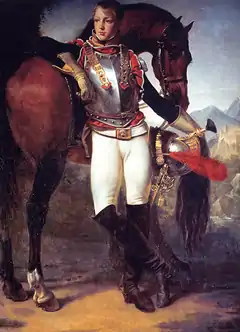
At the Salon of 1804, Gros debuted his painting Bonaparte Visiting the Plague Victims of Jaffa. The painting launched his career as a successful painter. It depicts Bonaparte in Jaffa visiting soldiers infected with the bubonic plague. He is portrayed reaching out to one of the sick, unfazed by the illness.
While Bonaparte did actually visit the pesthouse, later, as his army prepared to withdraw from Syria, he ordered the poisoning (with laudanum) of about fifty of his plague-infected men.[7] The painting was commissioned as damage control when word spread of his actions. The painting is in the neoclassical style, though it shows elements such as the lighting and a taste for the exotic that are precursors to the upcoming Romantic ideals.
Later life and death
In 1810, his Madrid and Napoleon at the Pyramids (Versailles) show that his star had deserted him. His Francis I and Charles V, 1812 (Louvre), had considerable success, but the decoration of the dome of St. Genevieve (begun in 1811 and completed in 1824) is the only work of Gros's later years which shows his early force and vigour, as well as his skill. The "Departure of Louis XVIII" (Versailles), the Embarkation of Madame d'Angoulême (Bordeaux), the plafond of the Egyptian room in the Louvre, and finally his Hercules and Diomedes, exhibited in 1835, testify only that Gros's efforts – in accordance with the frequent counsels of his old master David – to stem the rising tide of Romanticism only damaged his once brilliant reputation.[5]
Again citing the 1911 Encyclopædia Britannica, "Exasperated by criticism and the consciousness of failure, Gros sought refuge in the gros[ser] pleasures of life." On 25 June 1835, he was found drowned on the shores of the Seine at Meudon, near Sèvres. From a paper which he had placed in his hat, it became known that "tired of life, and betrayed by last faculties which rendered it bearable, he had resolved to end it."[5]
Renown
Gros was made a member of the Legion of Honour on 22 October 1808 by Napoleon,[8] after the Salon of 1808, at which he had exhibited the Battle of Eylau.[6] The number of Gros's pupils was very great and was considerably augmented when, in 1815, David quit Paris and gave over his own classes to him.[5]
Under the Bourbon Restoration, Gros became a member of the Académie des Beaux-Arts,[9] a professor at the École des Beaux-Arts, and a member of the Order of Saint Michael. He was granted the title of baron in 1824 by King Charles X of France.[1]
Gros had also been an inspiration to Eugène Delacroix, especially with his work in lithography. The two both worked in the same time period, and both did portraits of Napoleon. However, at one point, Gros had referred to Delacroix's Chios and Missolonghi as "a massacre of art".
G. Dargenty produced a book titled: Les Artistes Celebres ("Famous Artists"), Le Baron Gros, GILBERT WOOD & Co., London.
M. Delcluze gave a brief notice of his life in Louis David et son temps ("Louis David and his times"), and Julius Meyer's Geschichte der modernen französischen Malerei ("History of Modern French Painting") contains what Britannica cites as an excellent criticism on his works.[5]
Iconography
| Image | Title | Date | Dimensions | Collection |
|---|---|---|---|---|
 | Autoportrait | 1795 | Palace of Versailles | |
 | Madame Pasteur | 1795–1796 | The Louvre | |
| Portrait of Madame Bruyere | 1796 | 79 × 65 cm | Bristol City Museum and Art Gallery | |
 | Bonaparte at the Pont d'Arcole | 1796 | 130 × 94 cm | Palace of Versailles |
| The Death of Timophanes | 1798 | 44.4 × 57.6 cm | The Louvre | |
 | Portrait of Christine Boyer | c. 1800 | 214 × 134 cm | The Louvre |
 | The Battle of Nazareth | 1801 | 136.1 x 196.4 cm | Musée des Beaux-Arts de Nantes |
 | Sappho at Leucate | 1801 | 122 × 100 cm | Musée Baron Gérard, Bayeux |
 | First Consul Bonaparte | 1802 | 205 × 127 cm | Musée de la Légion d'honneur |
 | Bonaparte Visiting the Plague Victims of Jaffa | 1804 | 715 × 523 cm | The Louvre |
.jpg.webp) | Gérard-Christophe-Michel Duroc, duc de Frioul (1772–1813) | 1805 | 218 × 142 cm | Palace of Versailles |
 | Battle of Aboukir, July 25, 1799 | 1806 | 578 × 968 cm | Palace of Versailles |
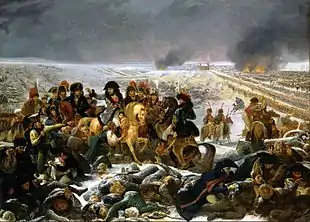 | Battle of Eylau, February 9, 1807 | 1807 | 104.9 × 145.1 cm | The Louvre |
 | Portrait of the French composer Pierre Zimmermann | 1808 | 118.5 × 91 cm | Palace of Versailles |
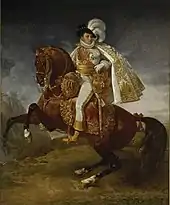 | Equestrian portrait of Jérôme Bonaparte | c. 1808 | 321 × 265 cm | Palace of Versailles |
 | Equestrian portrait of Prince Boris Yusupov | 1809 | 321 × 266 cm | Pushkin Museum |
 | Battle of the Pyramids | 1810 | 389 × 311 cm | Palace of Versailles |
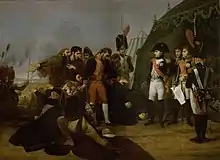 | Napoleon accepts the surrender of Madrid, 4 December 1808 | 1810 | 361 × 500 cm | Museum of French History |
 | The Horse of Mustapha Pasha | c. 1810 | 89 × 175 cm | Musée des Beaux-Arts et d'archéologie de Besançon |
 | Portrait of General Claude Legrand | c. 1810 | 245 × 172 cm | Palace of Versailles |
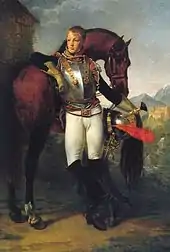 | Portrait of Second Lieutenant Charles Legrand | c. 1810 | 249 × 162 cm | Los Angeles County Museum of Art |
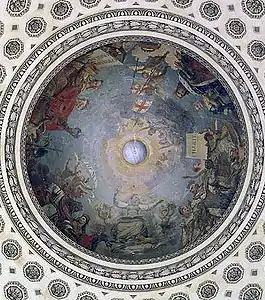 | The Apotheosis of Saint Genevieve | 1811–1824 | Panthéon de Paris | |
| François I and Charles V Visiting the Church of Saint-Denis | 1812 | The Louvre | ||
 | Equestrian portrait of Joachim Murat | 1812 | 89 × 175 cm | Musée des Beaux-Arts et d'archéologie de Besançon |
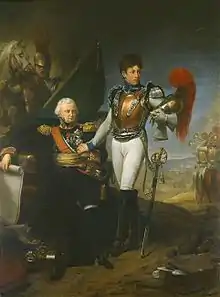 | General Baston de Lariboisière and his son Ferdinand | c. 1815 | Musée de l'Armée | |
.jpg.webp) | Honoré-Charles Baston de Lariboisière | 1815 | 73 × 59 cm | Private collection |
| Departure of Louis XVIII from the Palace of the Tuileries on the Night of 20 March 1815 | 1817 | 405 × 525 cm | Palace of Versailles | |
 | Embarkation of Madame d'Angoulême | 1819 | 326 × 504 cm | Musée des Beaux-Arts de Bordeaux |
 | Count Jean-Antoine Chaptal | 1824 | Musée des Beaux-Arts de Bordeaux | |
 | The Genius of France Giving Life to the Arts and Protecting Humanity | c. 1827 | The Louvre | |
 | Hercules and Diomedes | 1835 | 426 × 324 cm | Musée des Augustins |
 | Portrait of Pierre Daru | 19th century | 216 × 142 cm | Palace of Versailles |
See also
Notes
- "Antoine-Jean Gros | An Introduction to 19th Century Art". Retrieved 12 June 2017.
- "Ministère de la culture - Baron Gros". Retrieved 12 June 2017.
- The Napoleon Series
- Profile of Pierrette-Madeleine-Cécile Durand at the Dictionary of Pastellists Before 1800.
-
 One or more of the preceding sentences incorporates text from a publication now in the public domain: Chisholm, Hugh, ed. (1911). "Gros, Antoine Jean, Baron". Encyclopædia Britannica. 12 (11th ed.). Cambridge University Press. p. 615.
One or more of the preceding sentences incorporates text from a publication now in the public domain: Chisholm, Hugh, ed. (1911). "Gros, Antoine Jean, Baron". Encyclopædia Britannica. 12 (11th ed.). Cambridge University Press. p. 615. - Prendergast, Christopher. (1997). Napoleon and History Painting: Antoine-Jean Gros's La Bataille d'Eylau. Oxford: Clarendon Press. ISBN 0-19-817402-0
- Peterson, Robert K. D.; "Insects, Disease, and Military History: The Napoleonic Campaigns and Historical Perception"; American Entomologist 41:147–160. (1995) "Archived copy". Archived from the original on 3 March 2016. Retrieved 26 March 2015.CS1 maint: archived copy as title (link) retvd 3 26 15
- "Ministère de la culture - Base Léonore". Retrieved 12 June 2017.
- "Ministère de la culture". Retrieved 12 June 2017.
References
- Chu, Petra ten-Doesschate. (2006). Nineteenth-Century European Art. Upper Saddle River, New Jersey: Prentice Hall. pp. 126–127. ISBN 0-13-188643-6
External links
| Wikimedia Commons has media related to Antoine-Jean Gros. |
- Antoine-Jean Gros – The J. Paul Getty Museum website
- Paintings by Antoine-Jean Gros